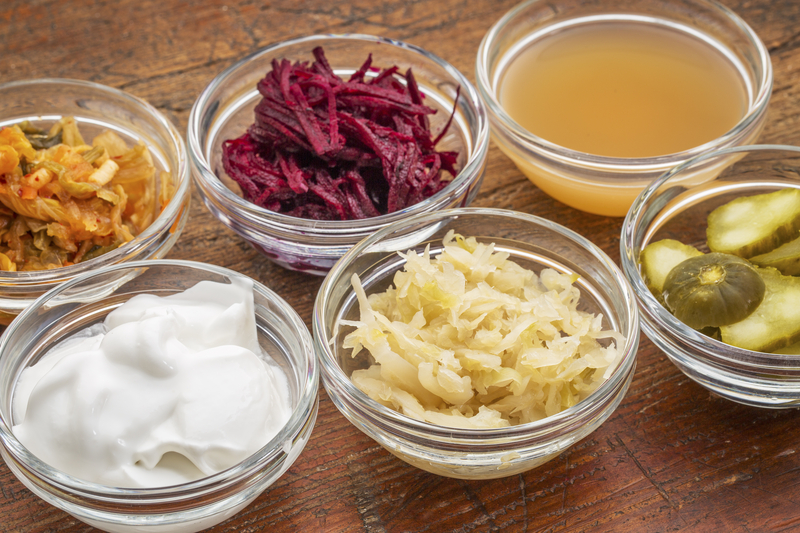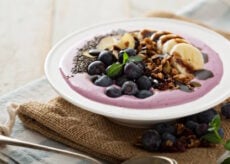How to Reset Your Gut (in 9 Simple Steps)

When it comes to staying healthy, it’s not just about you. Really. You, in fact, aren’t just you. Your body is made up of your human cells, but that number is vastly outnumbered (10 to 1) by the bacteria, fungi, and other microbes that naturally live on and within you. And your overall health depends a great deal on their health. In short, our bodies can’t function properly without these healthy microbes. So, for their health and yours, you’ll want to quickly reset your gut any time it’s compromised.
Signs of an Unhealthy Gut
How do you know when your gut is compromised? There are some pretty obvious ways an imbalanced gut can make itself known. Symptoms to watch for include:
- Excess gas (i.e., belching and farting)
- Bloating and tummy distension
- Changes in bowel movements (e.g., frequency, texture, color, etc.)
- Heartburn or reflux
- Acne or rosacea
- Dull, brittle hair or nails
What’s more, when the gut isn’t healthy and happy, all sorts of issues can arise. Keeping the bacteria balanced not only supports the immune system, it also lowers the risk for:
- Weight gain, metabolic syndrome, and obesity
- Heart disease
- Diabetes
- Mental health issues and depressed mood
- Cancer 1
There are around 100 TRILLION bacteria colonizing the digestive system alone, and there are some educated guesses that suggest our bodies are only 10% human. So, it may feel like an overwhelming task to reset the gut. Fortunately, with a little effort, you can begin to reset your gut for the better in just a matter of days. 2
How to Reset Your Gut (in 9 Steps)
You may have heard of the 5R Protocol, which provides a good framework for protecting the gut. The protocol is basically:
- Remove unwanted bugs, foods, and stressors
- Replace the good stuff, such as nutrients and prebiotics
- Repopulate with beneficial bacteria
- Repair by supporting the gut lining
- Rebalance your nutrition plan and lifestyle to protect the gut.
That’s a nice, tidy protocol, but how exactly do you go about accomplishing all of this? I’m glad you asked. Here are nine steps for how to reset your gut.
Step 1: Reset Your Circadian Rhythm
We all have an internal body clock that carries out essential processes. The most well-known is the sleep-wake cycle. When it’s properly aligned, it promotes positive, consistent, restorative sleep. Sleep, of course, is also vital for gut health.
To help reset the gut, you may first need to reset your circadian rhythm for more restorative sleep. Step one is to go to bed at least 30 minutes before you normally do. Second, allow yourself to wake up naturally—with no alarm clock. If possible, do this for at least the next two to three days to begin to understand your body’s natural rhythm. After that, make sure you’re getting at least seven hours of quality sleep every night.
Step 2: Feed Your Gut a Healthy Diet
Take a good look at your diet. If it’s high in added sugars, refined fats, ultra-processed foods, and fatty animal protein yet low in fiber and vegetables (i.e., the Standard American Diet), not only are you not feeding yourself well, but you are killing off the beneficial bacteria in the gut too. This includes some of the most beneficial species, like Bifidobacterium and Eubacterium.
What should you eat instead? A diet that focuses mostly on whole-food nutrition is a great place to start. Increase your consumption of vegetables, fruits, and whole grains. Decrease your consumption of highly processed foods.
If this type of eating is new to you, though, ease into it. Going from minimal fiber to the recommended amount of at least 25 grams per day may overwhelm the system, and you may experience gas, bloating, and other uncomfortable side effects as your gut bacteria catches up.
One of the best diets to follow to set your gut up for success is the Mediterranean diet, which recommends a high intake of vegetables, fruits, cereal grains, nuts, and legumes; a moderate intake of fish and light meat and dairy products; and a low intake of sweets.
When compared to the standard American diet, the Mediterranean diet is higher in fiber, phytonutrients, vitamins, antioxidants, and minerals. In other words, the nutrients needed to cultivate a healthy microbiome. But it also provides delicious foods, and it doesn’t restrict any food types, so it’s easier to follow than many other plans.
Even if you don’t follow the Mediterranean diet (or something similar), most people will want to start to increase the amount of fiber for a healthy, happy gut. And ensure you eat a wide variety of plant-based foods as the more diverse your diet, the more diverse your microbiota. 3 Try adding foods you may not have eaten a lot of in the past—like parsnips, Brussels sprouts, eggplants, artichokes, or beets. Better yet, visit your local farmer’s market and get creative with the in-season vegetables and fruits. Not sure how to cook them? Chances are pretty good that Coach Cristina has an amazing recipe you can use!
Step 3: Add Fermented Foods
If you need to reset your gut, you likely need to help recolonize the beneficial bacteria. Fermented foods naturally provide these good microbes. Add some plain yogurt, kefir, kombucha, miso, sauerkraut, pickles, or kimchi to your meal plan. Remember to watch for any added sugar as that decreases the effectiveness of the food. Again, however, ease your way into eating more fermented foods if they haven’t been a part of your diet.
You can also choose a multi-strain probiotic supplement to help build up a strong colony of healthy bacteria. In addition, you can add foods that may support the gut lining like bone broth or a high-quality collagen powder.
Step 4: Stay Hydrated
How much water do you drink per day? While no one knows where the eight glasses recommendation started, it is at least a start for recommending we drink more. To stay adequately hydrated, however, you likely need 9 to 12 cups of water per day. In turn, staying hydrated helps keep your guts moving and functioning properly.
Before you sip, if possible, go ahead and filter your water. Much of the water from the tap contains chlorine, which is added to kill of bugs. It doesn’t care if those bugs are bad ones in the water or good ones in the gut. (Still, if given a choice between no water and tap water, go with tap water and ensure you stay hydrated.)
Step 5: Evaluate Your Habits
Do you smoke or vape? You already know that the universal advice is to stop. Yet another reason to quit is because, according to research, once people stop smoking, the microbial diversity in their guts increases. 4 Quitting isn’t easy, but if you keep trying, you continue to increase your chances of success. 5
Other habits that can disrupt the delicate balance of the gut microbiome include drinking to excess (i.e., more than one drink per day for women and more than two drinks per day for men). In contrast, because it provides prebiotics, a single glass of red wine may promote a healthy gut. 6
Another common microbiome disruptor is artificial sweeteners like aspartame and sucralose. Like refined sugar, these additives have a negative effect on microbiome diversity. 7
Step 6: Enjoy Consistent Exercise
Regular exercise appears to help increase microbial diversity, even if your diet isn’t entirely on point. But once you stop exercising, the positive effects are largely reversed. So, start exercising and then keep it up to help reset the gut. 8
Step 7: Dig the Dirt
Yes, we need to wash our hands regularly—especially when out and about—to protect against infection. At the same time, many of us are too clean. If we aren’t exposed to enough microbes, we can prevent the immune system from being properly educated on how to fight infections. 9 To ensure your microbiome gets the exposure you need, play with a pet, play outside, dig in the dirt, garden, walk barefoot or lounge in the grass, and don’t be afraid to get a little dirty.
While you’re at it, kick the harsh chemical cleaners like bleach, ammonia, and strong antiseptics to the curb. Instead, wash up with plain old soap and water to clean up yourself, your clothes, and your house.
Step 8: Invest in Oral Hygiene
Just as our bodies are too clean, so are our mouths. We can disrupt the microbiome in the mouth by using antibacterial toothpaste, floss, and mouthwash. 10 You can still keep your mouth healthy and your breath fresh without the antibacterial chemicals.
Step 9: Reduce Stress
Chronic stress can decrease beneficial bacteria, increase harmful bacteria, and increase intestinal permeability (i.e., leaky gut). Take time out to release stress and let go for you and your gut.
Meals are a good time to slow down. Taking time to eat your food allows digestion to begin in the mouth, where it should. You’ll also better chew your food, which allows for better digestion. And slowing down also allows you to see how specific foods make you feel. Pay attention as some foods—even those that are good for you—can make gut issues worse.
How to Reset Your Gut: A Wrap-Up
It doesn’t take long to reset your gut. But it’s even better to maintain a healthy gut long term. Incorporate small changes into your diet and lifestyle over time to help support a strong, healthy microbiome. In return for taking care of that estimated 90% of your body that’s not you, you could very well be rewarded with a stronger, better balanced immune system, greater heart and brain health, improved mood and well-being, decreased weight, and reduced risk for diabetes, reduced bloating, cramps, and abdominal pain, and better health in general.
That said, give it time and be patient. Especially if you have been eating a standard diet for a while, it can take time for your gut to get used to dietary changes. Start smaller and work your way up to give your gut time to catch up with the reset. If you start eating a bunch of pre- and probiotic foods (especially with lots of fiber) all at once, you could go through a pretty uncomfortable transition. Fortunately, you can dive into many of the other steps (e.g., increased hydration, dirt play, and exercise) without worry.









